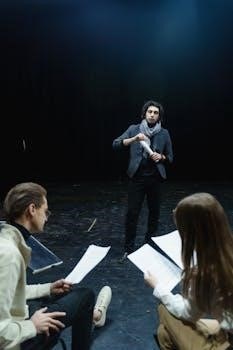An Actor Prepares PDF⁚ A Comprehensive Guide
Dive into Constantin Stanislavsky’s seminal work, “An Actor Prepares,” with our comprehensive PDF guide. Explore inner preparation, external techniques, and script analysis. Unlock character embodiment, avoid pitfalls, and discover practical exercises. Embrace the legacy and relevance of Stanislavsky’s system today for compelling performances.
Constantin Stanislavsky’s “An Actor Prepares” is a cornerstone of acting education, exploring the inner work an actor undertakes to fully inhabit a role. This volume, praised by Sir John Gielgud, unravels the complexities that often trouble actors and fascinate students. The book delves into the actor’s preparation, focusing on developing believable emotions for authentic performances.

Stanislavsky’s system, developed between 1911 and 1916, originally emphasized emotional recall, where actors draw upon personal memories to portray a character’s feelings. “An Actor Prepares” provides invaluable techniques and insights to navigate this process effectively, leading to nuanced and compelling portrayals. The book also highlights the importance of avoiding overacting and mechanical performances, encouraging a deeper connection with the character’s objectives and motivations.
This guide offers a glimpse into the skills taught at drama schools, providing insight into the acting profession itself. It serves as a practical resource for actors, teachers, and directors, answering the myriad requirements of actor training by combining theory and practice with simple, achievable techniques.
The Core Principles of Stanislavsky’s System

At the heart of Stanislavsky’s system lies the pursuit of truthful acting, achieved through rigorous self-analysis and understanding of the character’s inner world. A core principle involves the “magic if,” where actors ask themselves, “What would I do if I were in this character’s situation?” This encourages empathetic connection and believable action.
Another key element is the concept of objectives, motivations, and subtext. Actors meticulously analyze scenes, identifying what their character wants to achieve (objectives), the reasons behind their actions (motivations), and the unspoken meanings beneath the surface dialogue (subtext). This deep dive allows for nuanced portrayals that resonate with authenticity.
Emotional recall, while a significant early aspect, evolved within Stanislavsky’s system to emphasize imaginative creation over direct personal experience. Building personas through actions, tactics, and obstacles is also crucial. The system stresses the importance of observation, listening skills, and developing an actor’s perception to build a believable character. Finally, the actor must be relaxed to give the correct performance, and focus on what the character wants.
Inner Preparation⁚ Emotional Recall and Imagination
Stanislavsky’s system emphasizes a deep dive into inner resources, utilizing both emotional recall and imagination to fuel authentic performances. Emotional recall, initially a cornerstone, involves accessing past experiences to evoke corresponding emotions within the actor. This technique aims to create a genuine emotional connection to the character’s circumstances.
However, Stanislavsky later cautioned against solely relying on emotional recall, recognizing its potential to become forced or manipulative. He shifted focus towards imagination as the primary driver of inner preparation. Actors are encouraged to vividly imagine the character’s world, relationships, and motivations, allowing emotions to arise organically from this imaginative landscape.
The “magic if” plays a crucial role here, prompting actors to consider how they would feel and behave if they were truly in the character’s shoes. This sparks empathy and fuels the imaginative process. Through dedicated exercises and exploration, actors cultivate a rich inner life for their characters, leading to believable and compelling portrayals on stage or screen. It also helps remove the barrier between actor and character.
Outer Techniques⁚ Body, Voice, and Movement
While inner preparation forms the emotional core of a performance, Stanislavsky’s system also emphasizes the importance of outer techniques – the skillful command of body, voice, and movement. These elements serve as the physical manifestation of the character’s inner life, bringing their emotions and intentions to life for the audience.
Body control involves cultivating awareness of posture, gesture, and physical habits. Actors learn to embody the character’s physicality, whether it’s a regal bearing or a nervous twitch. Voice training focuses on projection, articulation, and vocal variety. Mastering these skills allows actors to communicate the character’s thoughts and emotions with clarity and impact.
Movement encompasses everything from walking and sitting to complex choreography. Actors explore how the character moves through space, reflecting their personality and emotional state. By integrating these outer techniques with inner preparation, actors create fully realized characters, seamlessly blending internal emotions with external expression. It is a vital part of creating believable emotion for the audience to latch on to.
Analyzing the Script⁚ Objectives, Motivations, and Subtext
Script analysis is a cornerstone of Stanislavsky’s method, providing the foundation for a truthful and compelling performance. It involves a deep dive into the text to uncover the character’s objectives, motivations, and the hidden layers of subtext that drive their actions and interactions.
Identifying the character’s objectives – what they want to achieve in each scene – is crucial. These objectives provide a clear direction for the actor’s choices, guiding their actions and reactions. Understanding the character’s motivations – the reasons behind their desires – adds depth and complexity to their portrayal.
Uncovering the subtext – the unspoken thoughts and feelings that lie beneath the surface of the dialogue – is essential for creating a nuanced performance. Actors must explore what the character is really saying, often through nonverbal cues and subtle gestures. By meticulously analyzing the script, actors can create a more nuanced and compelling portrayal of their characters.
Building a Character⁚ From Analysis to Embodiment
Building a character is the culmination of diligent script analysis and the application of various acting techniques. It’s the process of transforming from an actor into the character, embodying their thoughts, feelings, and physical presence. This involves translating the insights gained from analyzing the script into tangible actions and choices on stage.
The journey begins with understanding the character’s objectives, motivations, and subtext. This understanding informs the actor’s choices regarding physicality, voice, and emotional expression. Actors must explore the character’s background, relationships, and experiences to create a fully realized individual.
Embodiment is the final stage, where the actor fully inhabits the character’s persona. This involves adopting their posture, gait, and mannerisms, as well as allowing their emotions and thoughts to flow naturally. Through careful preparation and committed embodiment, actors can create believable and engaging characters that resonate with the audience.
Common Pitfalls⁚ Avoiding Overacting and Mechanical Performance
One of the most significant challenges for actors is avoiding the traps of overacting and mechanical performance. Overacting often stems from a desire to impress or an attempt to force emotions, resulting in a portrayal that feels artificial and unconvincing. It’s crucial to ground the performance in truth and authenticity, allowing emotions to arise organically from the character’s circumstances.
Mechanical performance, on the other hand, occurs when actors rely on pre-determined gestures and line readings without genuine emotional connection. This can lead to a flat and lifeless portrayal that lacks depth and nuance. To combat this, actors must constantly engage with the text and the character’s inner life, allowing their choices to be driven by genuine impulses.
Finding the balance between emotional depth and restrained expression is key. Actors should strive for a natural and believable portrayal, avoiding both excessive theatrics and robotic delivery. By focusing on truthfulness and authenticity, actors can create compelling performances that resonate with audiences.
Practical Exercises Inspired by “An Actor Prepares”
“An Actor Prepares” offers a wealth of inspiration for practical exercises designed to enhance an actor’s skills. One fundamental exercise is emotional recall, where actors delve into their personal memories to access genuine emotions that can be channeled into their performance. This technique helps to create authentic and believable portrayals.

Another valuable exercise involves exploring objectives and motivations. Actors should analyze their character’s goals in each scene, identifying what they want to achieve and why. This process helps to drive their actions and choices, adding depth and complexity to their performance. Improvisation exercises can also be incredibly beneficial, encouraging actors to think on their feet and respond spontaneously to unexpected situations. These exercises enhance their ability to stay present and connected to the character.

Furthermore, sensory exercises, such as focusing on specific sounds, smells, or textures, can help to heighten an actor’s awareness and create a more immersive experience. By engaging with these exercises, actors can develop a deeper understanding of their craft.
The Legacy of “An Actor Prepares” and its Relevance Today
“An Actor Prepares” has left an indelible mark on the world of acting, shaping the training and techniques of generations of performers. Constantin Stanislavsky’s system revolutionized the approach to acting, emphasizing the importance of inner truth and emotional authenticity. The book’s influence extends far beyond the stage, impacting film and television acting as well.
Even today, “An Actor Prepares” remains a cornerstone of actor training programs worldwide. Its principles of emotional recall, objective analysis, and character embodiment continue to be relevant for actors seeking to create compelling and believable performances. In an era of increasing realism in entertainment, Stanislavsky’s emphasis on truthful acting resonates more than ever.
The book’s focus on understanding human behavior and motivations is invaluable for actors seeking to connect with their characters on a deeper level. While some aspects of Stanislavsky’s system have been adapted and reinterpreted over time, the core principles remain essential for actors striving for excellence.
